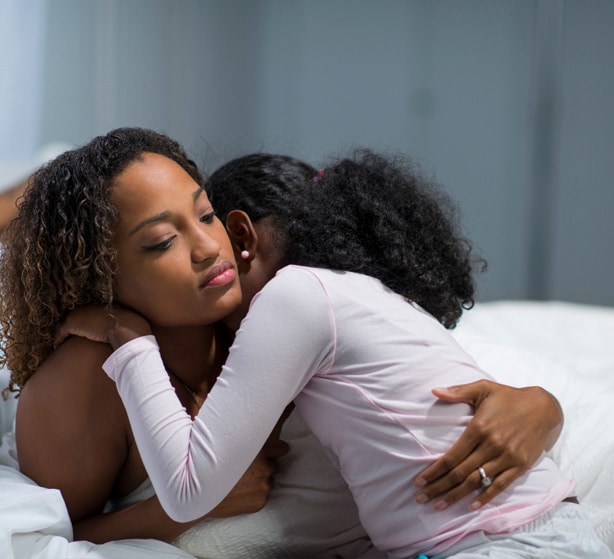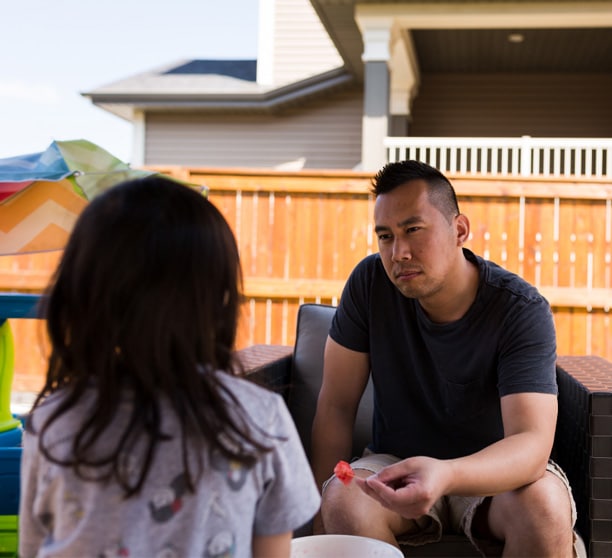How to Identify Sexual Abuse: A Prevention Guide for Parents
Child sexual abuse can, unfortunately, happen at any age. To help keep your children safe, we’ve created this guide as one of our parent resources to give you some ideas of what to look out for.
 Written and edited by our team of expert legal content writers and reviewed and approved by Attorney Matthew Bergman
Written and edited by our team of expert legal content writers and reviewed and approved by Attorney Matthew Bergman
- Content last updated on:
- June 12, 2025
Written and edited by our team of expert legal content writers and reviewed and approved by

- Content last updated on:
- June 12, 2025
What You’ll Learn
- Warning Signs of Sexual Abuse in Children and Teens
- Is my child or teen at risk of sexual abuse?
- Can social media influence sexual behaviors in children and teens?
- Social Media’s Impact on Sexual Abuse
- Child Grooming
- Signs of Sexual Abuse in Your Child or Teenager
- What should you do if you suspect your child has been sexually abused?
- Talking to Your Child About Sexual Abuse
- How can I protect my child or teen from sexual abuse?
Child sexual abuse involves any interaction between a child and an adult (or another child) in which the child is used for the sexual stimulation of the perpetrator or an abuser. This type of abuse can involve both touching and non-touching behaviors.
Due to their age, children cannot comprehend or give informed consent to sexual activity. Thus, it’s important for adults and parents to be aware of the potential for child sex abuse, to understand the ways that it might occur, and to watch out for any potential signs that it may have happened.
While child sex abuse is an issue in settings such as the home or school, it’s also a problem online. As more children have established a presence online through the use of social media and gaming websites, the opportunities for online sexual abuse have also increased.
Studies show that 53% of children own a smartphone by the age of 11. Most use their phones for viewing videos, playing games, and communicating with their friends. However, there is the potential for them to become targets of abusers if they form connections with older individuals online.
The impact of child sex abuse on the victim and their family can be quite severe. There may be medical costs associated with physical and mental conditions that develop as a result of the abuse. It can also lead to problems in family dynamics, and parents or siblings may develop medical issues relating to the abuse as well.
Studies show that 1 in 4 girls and 1 in 13 boys experience child sexual abuse at some point in childhood. Of those who experience sexual abuse, approximately 90% of abuse is perpetrated by someone the child or child’s family knows.
Child sexual abuse is frequently underreported because the child may be in fear or not know who to turn to. For this reason, it becomes even more important to recognize the signs of potential child sexual abuse and stop it from occurring.
Warning Signs of Sexual Abuse in Children and Teens
There are a number of warning signs for parents and other adults to look out for that may indicate child sexual abuse. These include physical, behavioral, and emotional red flags.
Physical Signs
Some of the physical signs of child sexual abuse include:
- Unexplained injuries, especially to the genital area
- Pain, bleeding, or discharge in the genitals or mouth
- Persistent or recurring pain with urination or bowel
movements - Toileting accidents unrelated to toilet training
- Sexually transmitted infections (STIs) or pregnancy
Parents and adults should be especially concerned about unusual physical complaints related to the genitals.

Behavioral Signs
Many of the more obvious signs of child sexual abuse can be witnessed through the behavior of a child. These include:
- Knowledge about sexual topics that goes beyond the
child’s developmental stage - Withdrawal from previously regular interactions and
conversations with peers - Desire to spend lots of time alone
- Reluctance to leave school or other activities; not wanting to go home
- Avoiding certain places or people, especially if they used to be excited about them
- Behavioral regression
- Frequent absences from school or other activities
- Having money, toys, or gifts without being able to explain where they came from
- Drug or alcohol abuse
- Running away from home
- Fear of closeness with others
If an adult witnesses any of these behavioral changes in a child, they should be addressed immediately.

Emotional Signs
Common emotional signs that indicate child sexual abuse include:
- Nightmares, trouble sleeping, or fear of being alone at night
- Change in mood or personality
- New or increased depression, aggression, worry, or fearfulness
- Decrease in confidence or the way they feel about themselves
- Losing interest in school, friends, hobbies, or things they used to love
Any signs of emotional abuse should lead to a conversation with the child to determine what the root cause of the changes are.

Is my child or teen at risk of sexual abuse?
Unfortunately, any child or teen is potentially at risk for sexual abuse. However, staying aware of the child’s normal behavior and addressing any changes immediately can help to prevent child sexual abuse.
Risk factors associated with an increase in child sexual abuse include:
- Being female, although males may also potentially be victims of child sexual abuse
- Physically or mentally handicapped children
- History of past abuse
- Poverty
- Psychological or cognitive vulnerability
- Single parent homes
- Social isolation
- Parent with mental illness, or alcohol or drug dependency
- Social media or online networking from a young age
While certain risk factors for child sexual abuse do exist, it’s important to realize that any child may be a victim, no matter their background.
Can social media influence sexual behaviors in children and teens?
While there have not been too many studies done that investigate the link between sexual behaviors in children and teens and social media, it does appear likely that social media has an impact. Children and teens with social media accounts are constantly bombarded with advertisements and pictures that may suggest sexual activity.
This is especially true on social media sites such as Facebook, Instagram, TikTok, and Snapchat. All of these sites concentrate on visual stimulation through the use of videos and pictures, and may lead to an increased focus on sex among teens and children.
One study that examined the correlation between text messaging and sexual activity found that greater use of online text messaging was associated with higher sexual risk.
However, the same study found that parents who monitored their children’s online activity regularly resulted in fewer risky sexual behaviors.
Social Media’s Impact on Sexual Abuse
The rise of social media, which in some ways has been extremely positive and allowed people from all over the world to connect with one another, has also presented a new wave of privacy issues.
Prior to the establishment of the internet, it was unlikely for children to be known outside of their normal hangouts at home, school, and in their neighborhood.
However, the proliferation of social media has led many children and teens to establish their own profiles online. These profiles provide identifying information, such as age, location, interests, and friends, all of which can be used by abusers to target children and teens.
Children and teens are less likely than adults to be aware of privacy concerns and may be more willing to chat with those they don’t know online. This makes them prime targets for sexual abuse techniques such as grooming.
In addition to privacy concerns, the advent of social media has led to an increased opportunity for abusers to share child sexual abuse material online. The National Center for Missing & Exploited Children has seen a 15,000% increase in abuse files reported in the last 15 years.
Because social media platforms make little to no effort to verify the age of their users, adults posing as children frequently interact with minor users and persuade them to provide nude photographs and exchange graphic sexual content. Explicit photographs posted online can result in psychic trauma and self-harm among minor users.
Pedophiles use social media platforms to groom underage users, and traffickers use social media to promote and facilitate commercial sex, commonly known as prostitution and sex work.
Child Grooming
There are specific tactics that abusers use to gain access to children or teens online. This practice is known as online grooming. While grooming may take a variety of different forms, it often follows a similar pattern.
If you notice that your child or teen is spending a lot of time with someone new, it’s smart to learn more about them to determine if the relationship is legitimate or may have the potential to become abusive.
Victim Selection
Abusers often observe possible victims and select them based on ease of access or their perceived vulnerability.
Isolation of the Victim
Abusers will attempt to physically or emotionally separate a victim from those protecting them and may seek out opportunities to have contact with minors.
Trust Development
Abusers may attempt to gain trust of a potential victim through gifts, attention, sharing “secrets,” and other means to make them feel that they have a caring relationship and to train them to keep the relationship secret.
Desensitization
Abusers may start to touch a victim in ways that initially appear harmless, and later escalate to increasingly more sexual contact. Abusers may also show the victim pornography or discuss sexual topics with them.
Normalization
Teens and children may not be as aware of grooming tactics, and take conversations at face value. Be alert if your teen has a relationship with an adult that includes secrecy, undue influence or control, or seems to push personal boundaries.
Signs of Sexual Abuse in Your Child or Teenager
There are a number of signs to look out for in your child or teenager that may indicate sexual abuse. Oftentimes, the signs are not physical, but behavioral or emotional in nature. These signs may include any of the below:

Anxiety and depression

Sleep disturbances, including nightmares or night terrors

Change in eating habits

Unusual fear of certain people or places

Lack of interest in friends, sports, or other activities

Poor self-esteem or avoidance of relationships

Overly compliant behavior
You should talk to a child or teen who exhibits one or more of these symptoms to determine what the cause is.
What should you do if you suspect your child has been sexually abused?
If you suspect your child has been sexually abused, have a conversation with them. Try to find out what’s occurring and what the abuse has consisted of. If they’re unwilling to talk, it’s important to reach out for additional assistance on how to handle the situation.
Darkness to Light offers a child sexual abuse hotline that can be reached at 866.FOR.LIGHT (866.367.5444). The organization helps children and adults who need local information or resources concerning sexual abuse.
There are a number of other resources available that support parents, children, and other adults with sexual abuse cases. You should also reach out to your family doctor for medical help and psychological resources for assistance.

Talking to Your Child About Sexual Abuse
If you suspect your child has been sexually abused, it’s important not to react angrily or emotionally. Don’t guilt or shame them. Remain calm when discussing the abuse with them.
You must also speak openly with them. Don’t sugarcoat the situation or avoid being transparent about what happened to them. If the abuse occurred online, try to get information from your child about who the online user is and how they were accessed so that you may report them.
However, don’t pressure your child to remember details or provide you with information. Instead, wait for them to tell you. Let the authorities know the person accessed your child online. They’re trained to handle these types of situations objectively and compassionately.

How can I protect my child or teen from sexual abuse?
While you can’t protect your child from every situation, you can stay engaged in your child’s life and be aware of behavioral changes. It’s also smart to stay on top of their social media and internet usage, and encourage them to participate in activities away from the screen.
Watch for Signs
Watch for any of the behavioral, emotional, or physical signs indicated in this article. The sooner you’re able to identify a problem, the sooner you can get your child the help they need and protect them from further abuse.
Encourage Socialization Through Activities
Schools offer a wide variety of activities that children can participate in, including sports, arts, and music. This allows them to develop and enhance their skills as well as encourages relationships with children their own age.
Promote a Healthy Lifestyle
Exercise and sleep are important to combat depression and anxiety. Adopting a diet that has lots of fruits, vegetables, and protein also encourages a healthy lifestyle.
Monitor Social Media Use and Limit Time Spent on Online Networking Sites
Social media can be a haven for perpetrators who seek out children and teens for potential sexual abuse. Stay on top of your children’s internet activity and be wary of new relationships that develop online.
